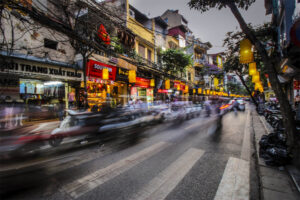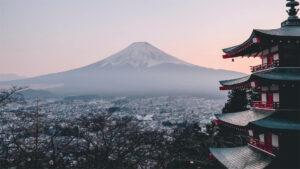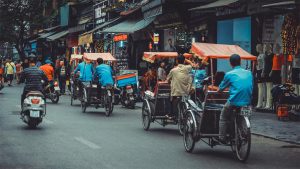Peter’s new book, Disunited Nations, is available for pre-Order now on IndieBound, Apple Books, Hudson Booksellers, Barnes & Noble, Amazon, Google Play, or Kobo.
The Philippine government this week began the formal legal process of ejecting US forces from the country and ending the US-Philippine alliance. Chinese involvement in the decision isn’t so much suspected as assumed. The few pundits who can tear themselves away from the American primary process are bemoaning another American strategic retreat.
Me? Not so much.
The Philippines is one of those countries I normally have a hard time getting excited about. As a shattered archipelago it has a damn hard time holding itself together in anything that the rest of the world might recognize as a united nation-state. Secessionist struggles define the country’s modern incarnation, and outside of the major island of Luzon, the place is a riot of different ethnicities and languages. Add in rugged, tropical terrain and it will never be a local, much less regional power.
Which is hardly to say that the place doesn’t matter at all.
The Philippine Archipelago is part of a series of islands that roughly parallel the coast of the East Asian mainland at about a distance of 1000 miles. Those islands – in addition to the Philippines, they include the modern states of Japan, Taiwan, Malaysia and Indonesia – are the most significant factor keeping China from becoming a power of significance. At no point in the 3500 years of Chinese history have the Chinese been able to sustainably trade directly with the outside world without leaning on a foreign partner, be it one of the members of the island nations surrounding China’s coasts, SE Asia or even India.
With a singular exception: Today.
In the aftermath of World War II the Americans crafted the first global Order, in essence creating a global trade and security network as compensation for other countries siding with the Americans against the Soviets. In time this alliance expanded beyond Western Europe and the Western Hemisphere into East Asia, where it ultimately admitted Japan, Korea, the Philippines, Taiwan, Indonesia, Malaysia – and with Nixon’s trip to Beijing – China itself.
For the first time ever, everyone was on the same side, and the Americans actively prevented Order members from going to war with one another. This Order is what has enabled the Chinese to escape imperial predation (most notably by Japan and Europe), access global consumer markets, and import whatever raw materials – first and foremost energy supplies – were required in order to fuel their economic integration and expansion.
All the Americans need to do if the goal is to destroy China as an economic and political entity, is go home. The Chain’s geography will take care of the rest.
Enter the Philippines. The place may be a mess, but that mess makes it the Chain’s weakest link. Should the Chinese succeed in ejecting American political and military influence from the Philippines, then the Chinese just might be able to break through into the wider world.
It isn’t quite that simple of course, and not just because an outside power managing the Philippines is as difficult a task as a local power ruling it. Gaining round-the-clock secure access for civilian vessels would require militarizing the Philippines in a manner similar to what the Japanese and Americans did in the years just before, during and after World War II. That will generate just as much neoimperial heartburn for the Chinese as it did for their predecessors.
But the bigger issue is that the Philippines are not quite what China needs.
Again, it is an issue of geography. The Philippines are not at the Chain’s northern end where they could threaten the Chinese core or serve as the gateway to North America, nor at the south end where they’d be on the direct path to China’s core energy sources in the Persian Gulf and the large markets of Europe. Instead the Philippines are in the middle, on the path to the wide-open empty of the Central Pacific.

What the Chinese really need if they are to punch through the Chain is the Strait of Malacca, the point where Singapore, Malaysia and Indonesia come together to bracket the world’s busiest trade and energy chokepoint. Securing Malacca – and let’s be blunt, this means de facto occupying Singapore and Malaysia and Indonesia – would bring the Chinese 1000 miles closer to their goals, while also crunching Japanese access to the same. (Although even then, India and Taiwan remain very much in the way.)
Still, you’ve got to start somewhere.
Don’t look for the United States to fight this.
For one, the American military bases at Hawaii, the Wake and Midway Islands, complemented by America’s still-firm military relationships with Japan, Australia and Singapore are more than ample for the Americans to project power to the Chain and the waters further west. Most of China’s navy has an operational range of no more than 1000 miles from their bases, which brings them to – but not through – the Chain. Anything short of a flat-out occupation of the Philippines in total won’t change that. Even then it would only be the very first step of a very long journey.
For two, the Americans are getting out of the global management game, so reducing their forward positions in East Asia, Europe and the Middle East is simply inevitable. Getting kicked out isn’t good optics, but as the Philippines are one of the less valuable bits, it makes sense the Americans would decamp sooner rather than later.
For three, the American-Philippine relationship has always been a bit…fraught. The Americans conquered the Philippines in the Spanish-American War of 1898, something the Philippines are of mixed minds about. America’s subsequent occupation of the place combined some of the less savory aspects of later wars in Vietnam and Iraq, making the Americans of mixed minds. Ongoing American operations against Islamic secessionists on the southern Philippine island of Mindanao are in reality one of America’s longest-ever military operations, something the Americans have long felt was simply the price having a footprint in the country. Few tears will be shed in America when the GIs come home for good. If anything, much bubbly will be popped on the hilarious day when Chinese forces wade into that absurd clusterf**k.
For four, even if the Americans were enthusiastic about staying, the Philippines have recently taken a political dive that Americans find…distasteful. Incumbent Philippine President Rodrigo Duarte is a less competent, less polite, more aggressive, more institutionally corrosive, more erratic, more violent version of Donald Trump. (Say what you will about Trump, he’s not actually calling upon his average supporter to go out and kill anyone he thinks is a problem. So far, conservatively, president-sponsored vigilante justice is directly credited for at least 5000 deaths between 2016 and 2018.) No, it isn’t the Americans you need to look to to counter this.
It’s the Japanese. While the Philippines taken alone are not a big deal, the archipelago’s flipping would represent the first real change in the region’s strategic structure since the Japanese defeat in 1945. For the US this is rather ho-hum, but the Americans don’t live in East Asia. The Japanese do. Japan’s navy could sail circles around China’s, but it operates at an extreme numerical disadvantage and its sail to strategically vital locales like the Persian Gulf are 2000-3000 miles further for the Japanese than the Chinese. Losing the Philippines isn’t a death-blow, but it certainly is a step in the wrong direction – especially if the Americans get out of the business of doing the heavy-lifting for Asian security. Expect a flotilla of Japanese diplomacy, military assistance, tech transfers and outright bribes as Tokyo attempts to pick up what the Americans are dropping.
Strategic issues aside, there is one aspect of all this the average American is likely to notice.
When the great outsourcing boom got going in the 1990s, much of the call-center work that Americans once did shifted to India, a low-wage country colonized by the Brits. Unfortunately for the Americans, many are uncomfortable with the mish-mash inflections of South Asian and British accents that makes up Indian English. But the Philippines had been a de facto American colony for a century. English-speakers in the Philippines sound much closer to the American Midwest than the rest of the world’s English speakers whose linguistic roots are much closer to the Brits. In the world of call-centers, the Indians now handle the rote technical work that is non-customer facing, while the Philippines are treasured for their people skills. That division of labor is unlikely to last should Manila go full-Beijing.
You think you hate automated call menus now, just wait for the abject horror to come…








